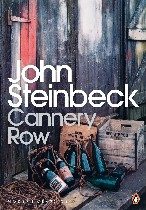 John Steinbeck •
John Steinbeck •
Cannery Row •
Steinbeck sets the stage for his ode to Monterey, California, with this description:
Lee Chong’s grocery, while not a model of neatness, was a miracle of supply. It was small and crowded but within its single room a man could find everything he needed or wanted to live and to be happy—clothes, food, both fresh and canned, liquor, tobacco, fishing equipment, machinery, boats, cordage, caps, pork chops. You could buy at Lee Chong’s a pair of slippers, a silk kimono, a quarter pint of whiskey and a cigar. You could work out combinations to fit almost any mood. The one commodity Lee Chong did not keep could be had across the lot at Dora’s.
No need to ask what Dora is purveying.
The book’s inhabitants are just as sharply realized. There are Mack and the boys, an assortment of scruffy ne’er-do-wells who doss down in abandoned drainage pipes, a rusted-out boiler, and a shack they grandly term the Palace Flophouse. There’s Lee Chong himself, “fingers moving like small restless sausages.” There’s Darling, a pointer pup who feasts on everyone’s shoes.
And at the center of this motley group is the marine biologist known to everyone simply as Doc. “His mind had no horizon—and his sympathy had no warp . . . He was concupiscent as a rabbit and gentle as hell.” The gritty waterfront district, rendered here in loving detail, fairly vibrates with their misadventures, from a disastrous celebration to a frog hunt that would have delighted Mark Twain.
The Monterey area honors Steinbeck with a museum, a plaza bearing his name, a yearly festival, a statue, and tours of locations found in his work. Steinbeck honored Monterey with Cannery Row, a glorious monument as fresh, comic, and touching now as when it appeared in 1945.





Your email address will not be published.